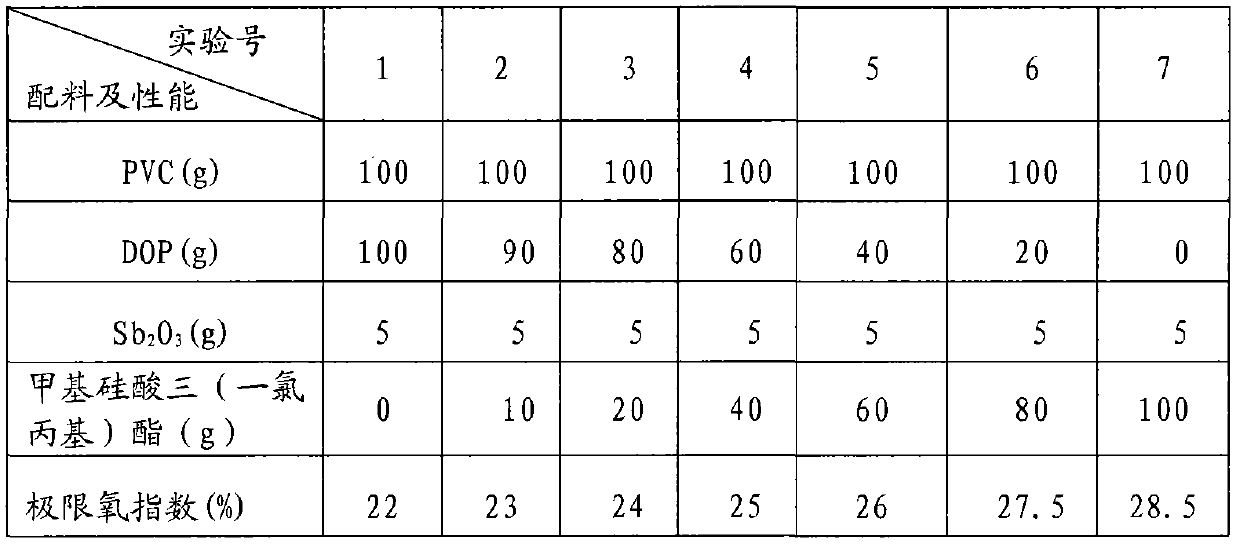Tri(chloroproply) methyl silicate compound and preparation method thereof
A technology of trichloropropyl methylsilicate, applied in chemical instruments and methods, compounds of group 4/14 elements of the periodic table, organic chemistry, etc., can solve development and application restrictions, silicon-based flame-retardant plasticization It solves the problem of comprehensive utilization, easy large-scale production, and low cost.
- Summary
- Abstract
- Description
- Claims
- Application Information
AI Technical Summary
Problems solved by technology
Method used
Image
Examples
Embodiment 1
[0018] Embodiment 1 is equipped with agitator, thermometer, dropping funnel, reflux condenser and in the 200ml four-necked flask that is connected with hydrogen chloride absorption device on the condenser, adds 0.2mol (29.9g) methyltrichlorosilane, then Add 0.6mol (56.7g) of monochloropropanol dropwise under the cooling condition of water bath, and control the temperature not to exceed 40°C with the dropping rate, and maintain reflux at 40°C for 8 hours after the drop is completed. After the hydrogen chloride is released, the reaction is completed, and 1.0g is added After the melamine is stirred evenly, a small amount of low boiling point matter is removed by distillation under reduced pressure, cooled and filtered to obtain a colorless liquid tris(monochloropropyl)methylsilicate, and the product yield is 90%. Its flash point (open cup): 200±5°C, decomposition temperature: 250±5°C, density 1.273g / ml, refractive index n D 25 = 1.4486.
Embodiment 2
[0019] Embodiment 2 Add 0.2mol (29.9g) methyltrichlorosilane in a 200ml four-necked flask equipped with agitator, thermometer, dropping funnel, reflux condenser and connected with a hydrogen chloride absorption device on the condenser, and then Add 0.64mol (60.48g) of monochloropropanol dropwise under the condition of cooling in a water bath, and control the temperature at a rate of addition not to exceed 40°C. g melamine, after stirring evenly, a small amount of low boiling point matter and excessive monochloropropanol (recycling) are removed by distillation under reduced pressure, cooling and filtering to obtain colorless liquid tris (monochloropropyl) methyl silicate, the product obtains The rate is 95%. Its flash point (open cup): 200±5°C, decomposition temperature: 250±5°C, density 1.273g / ml, refractive index n D 25 = 1.4486.
Embodiment 3
[0020] Example 3 In a 200ml four-neck flask equipped with a stirrer, a thermometer, a dropping funnel, a reflux condenser and a hydrogen chloride absorbing device at the mouth of the condenser, add 0.2mol (29.9g) of methyltrichlorosilane, and then Add 0.68mol (64.26g) of monochloropropanol dropwise under the condition of cooling in a water bath, and control the temperature at a rate of addition not to exceed 40°C. g melamine, after stirring evenly, a small amount of low boiling point matter and excessive monochloropropanol (recycling) are removed by distillation under reduced pressure, cooling and filtering to obtain colorless liquid tris (monochloropropyl) methyl silicate, the product obtains The rate is 96%. Its flash point (open cup): 200±5°C, decomposition temperature: 250±5°C, density 1.273g / ml, refractive index n D 25 = 1.4486.
PUM
| Property | Measurement | Unit |
|---|---|---|
| flash point | aaaaa | aaaaa |
| decomposition temperature | aaaaa | aaaaa |
| diameter | aaaaa | aaaaa |
Abstract
Description
Claims
Application Information
 Login to View More
Login to View More - R&D
- Intellectual Property
- Life Sciences
- Materials
- Tech Scout
- Unparalleled Data Quality
- Higher Quality Content
- 60% Fewer Hallucinations
Browse by: Latest US Patents, China's latest patents, Technical Efficacy Thesaurus, Application Domain, Technology Topic, Popular Technical Reports.
© 2025 PatSnap. All rights reserved.Legal|Privacy policy|Modern Slavery Act Transparency Statement|Sitemap|About US| Contact US: help@patsnap.com


